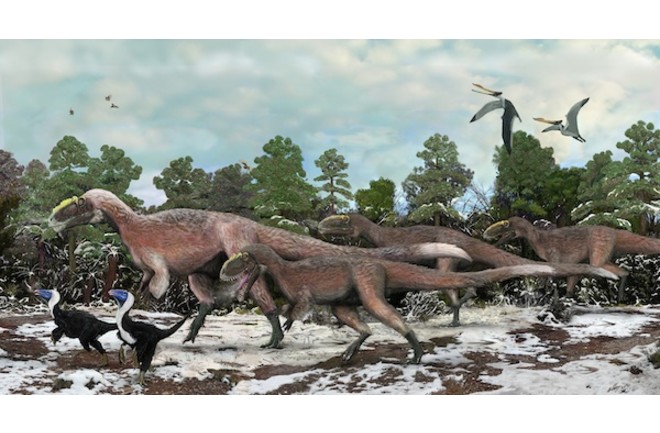
One smoggy afternoon in the summer of 2010, I took a walk down Xi Zhi Men Wai Avenue in Bejing. The ten-lane thoroughfare was packed with cars, buses, pedalos, and bicycles. But even here, in China’s hyperurbanized core, there were birds to keep me company. Sparrows shot around the roadside trees. Black and white magpies perched in the treetops, issuing their rattling calls. I was walking down Xi Zhi Men Wai Avenue to pay a visit to a museum, where I could take a close look at the fossilized remains of some ancient cousins to the magpies. I was going to see some feathered dinosaurs.

Feathers are one of the marvels of animal evolution–a combination of extreme beauty and extreme usefulness–but for over a century their fossil record stopped with the 145-million-year-old Archaeopteryx. It was a mix of bird anatomy such as wings and older vestiges of a reptilian origins, such as teeth and a long, bony tail. But in the past 20 years, paleontologists have found a series of spectacular fossils of dinosaurs with traces of feathers or feather-like structures on their skin. And most of them have turned up in China. So it only made sense for me to head for Beijing–and in particular, to the Institute for Vertebrate Paleontology and Paleoanthropology. There, a young paleontologist named Xu Xing and his colleagues have built up the most impressive collection of feathered dinosaur fossils on Earth.
When I entered the IVPP, I walked into a badminton game underway on an indoor court. IVPP students sliced at the shuttlecock below the glare of a giant marine reptile fossil bolted high on the wall. I took the elevator to the sixth floor, where I met Xu Xing, a slender middle-aged man. He had just finished playing some badminton himself and was still wearing an IVPP athletic uniform as he sat at his computer, answering email. We shook hands and he ducked out to change into civilian clothes. We then headed into the IVPP’s collection room.
Xu flipped green curtains from the shelves until he found a tray. A student helped him slide it out and set on the floor. Inside the tray was the fossil of a 125-million-year-old dinosaur called Beipiaosaurus. As I looked at the fossil, Xu explained what I was seeing. There were bones from the animal’s legs, skull, spine, and tail. There were also dark streaks surrounding parts of its body. In life, Xu said, they would have been stiff, broad bristles measuring several inches long.
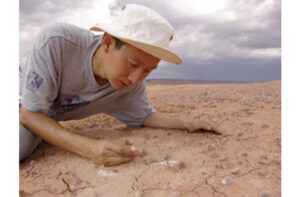
Xu helped me picture Beipiaosaurus in life. “It had a big bulky body, a long neck, and a small head,” he said. Walking on its hind legs, it was as tall as a man. But instead of killing to eat, it probably browsed on plants with grinding teeth. Its entire body would have been covered in soft, short filaments, with tufts of broad, long bristles sprouting off its neck and tail.
“It’s very bizarre,” Xu said, smiling.
The idea that birds evolved from dinosaurs has been kicking around for over a century, but it wasn’t till the 1970s that paleontologists presented a detailed argument based on the anatomy of the animals. John Ostrom of Yale University pointed out a number of similarities in the skeletons of birds and the skeletons of bipedal dinosaurs called theropods. But how feathers evolved during the transition from ground-running theropods to flying birds was a mystery.
So Xu was stunned in 1996 when he learned of the discovery of a small theropod in northeast China with bristle-like structures running down its back and tail. The 125-million-year-old fossil was christened Sinosauropteryx: the Chinese lizard bird.
Xu, an expert on theropods, thought the name was a mistake. “This is not a bird. It’s a dinosaur,” he told me. It had typical theropod legs for running, and its arms had no adaptations for flight. Nevertheless, Xu knew that Sinosauropteryx had opened a new age in paleontology. “This was something important that was going to change history,” he said.
Sinosauropteryx had been discovered by farmers in a province of China called Liaoning. The geological formations in the region turn out to be among the best places on Earth for preserving fossils of complete skeletons, along with traces of skin and other soft tissues. Xu and his IVPP colleagues set out for Liaoning in 1997 to find fossils of their own. Bureaucratic tangles and other delays bogged them down. They didn’t get to start digging until October. The days grew cold. It began to snow. Day after day, Xu and his colleagues failed to find anything. Finally, on the last day of their field season, a farmer invited Xu and is colleagues to look at a fossil he had found. The fossil was in fragments, but Xu could tell it was a theropod. When he brought it back to IVPP, he and his colleagues were able to reassemble the pieces. They noticed the fossil preserved bristles as well. They had found the first specimen of Beipiaosaurus.
Since then, digging for feathered dinosaurs has become an industry for poor farming communities in Liaoning. “If farmers find a fossil, it can change their life,” said Xu. “You couldn’t imagine how many people are involved.” As a result, IVPP and other Chinese institutions are now packed with new fossils of feathered dinosaurs and early birds.
As scientists compare all these fossils, a rough outline of the evolution of feathers is coming into view. It appears that the earliest theropod feathers were simple hollow shafts, which then evolved into more elaborate structures. The sequence of changes gets more complicated as scientists look at more dinosaur fossils. Complex feathers may have evolved more than once. Some dinosaurs may have evolved bizarre feather forms that exist on no bird today. The filaments on the tail of Beipaiosaurus turn out to have been very broad. Another dinosaur called Epidexipteryx sprouted a pair of ribbon-like tail feathers. “The more you look, the more complex the story gets,” Xu said.
I took notes as Xu talked, and stopped from time to time to take pictures to supplement my memory. I was on assignment for National Geographic, traveling with the photographer Robert Clark. My job was to tell the story, and Clark’s job was to take his typically gorgeous pictures. He wandered up and down the IVPP halls, tracking down fossils in various labs. But there was one fossil that Xu was working on that we would have to take a trip to see. It was too big to fit in the IVPP. It was, in fact, the fossil of the first gigantic feathered dinosaurs ever discovered.

Clark and I climbed into a van one morning with his assistants, and we drove out of Beijing, into what you might call the countryside, except that it was obviously on the cusp of becoming the outskirts of Greater Beijing. It took us an hour to reach a low-slung set of buildings that IVPP uses for storage. The staff lives on the site, keeping a garden plot and raising chickens. When we arrived, they sent off for a local forklift operator. Clarke unfurled a long piece of black cloth he had bought in a Beijing market the previous day. And then, slowly, the IVPP staff hauled out the pieces of the dinosaur.
Like most Chinese feathered dinosaur fossils, this one was in a slab, the bones pressed flat. The farmers who found it cut it out in pieces, and those pieces had ended up here at the warehouse. Each piece was about the size of a welcome mat, taking two people to lug it. It must have taken an hour for them to bring all the 125-million-year-old pieces out of storage and then puzzle over how they fit together. What made the puzzle particularly complex was the fact that the fossil included two dinosaurs, facing in opposite directions with their tails overlapping.
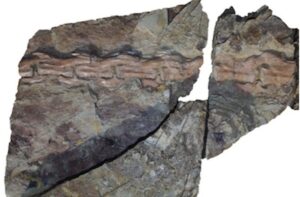
As the warehouse staff solved the puzzle, I looked closely at the pieces. These were big dinosaurs. They resembled Tyrannosaurus rex, and the big one of the fossilized pair might have been 25 feet long or longer. I could see the streaked marks of feathers on the tail, and patches on other parts of its body. Feathers don’t fossilize easily, and so it’s common to find feathered dinosaur fossils with traces of plumage only on some parts of their bodies. Scientists then have to judge whether the dinosaur only had feathers on some of their body in life, or whether they were fully cloaked and then some of their plumage failed to fossilize. It’s also possible that the dinosaur had different kinds of feathers, and some types fared better than others. (Even fossil birds, which were definitely covered completely in feathers, sometimes only retain patches of fossil feathers.)
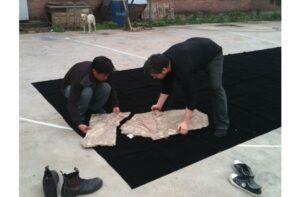
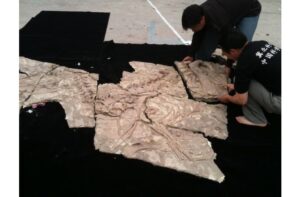
Clark borrowed a piece of plywood, slid it onto the forks of the forklift, and then lay on it to take pictures of the beasts. He showed me the pictures on a laptop, and they were magnificent. This was going to be a crown jewel in the story–the sort of thing you get to write about when you work for National Geographic.
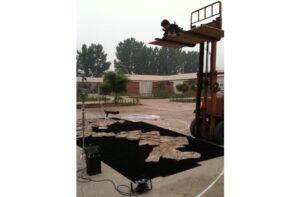
There was just one problem. Xu Xing and his colleagues hadn’t finished their study of the fossil. They hadn’t given the dinosaur a name. Until they had written a paper and gotten it accepted to a journal, they weren’t going to talk about it. And we were only allowed to take the picture on the understanding that we would only use it if our article came out after the fossil had safely entered the scientific literature.
I figured–or perhaps I just hoped–that things would work out. I flew back home and got to work on my story. I checked in with Xu by email every now and then, in the hopes that the paper was accepted, or at least written. It wasn’t. Xu and his colleagues couldn’t decide whether it was a new species, or just a well-preserved fossil of a previously discovered species called Sinotyrannus kazuoensis. When Xu took a look at the fossils of Sinotryannus, he wasn’t satisfied with how it had been described, and so he had to make a long, exacting study of that dinosaur, too.
Eventually I had to abandon all hope, and went on to write my story without the giant feathered dinosaur. Clark’s photograph remained on some magazine hard drive, unpublished. The piece we ended up with, published in Feburary 2011, came out nicely, I thought, but I was sad to leave about the best part of my trip to Beijing. Yet I had to respect Xu for his fierce loyalty to slow-cooked science. Just because a discovery is obviously spectacular doesn’t mean you should scrimp on the hard, tedious work of making sure you’re as right as you can possibly be.
In Xu’s case, slow-cooked science turned out to be really slow. It’s been almost two years since I went to Beijing and saw the fossil puzzle of the gigantic feathered dinosaurs. And only today have Xu and his colleagues published its details in the journal Nature.
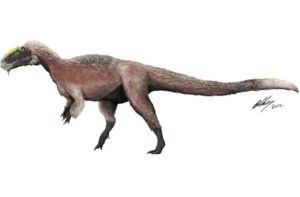
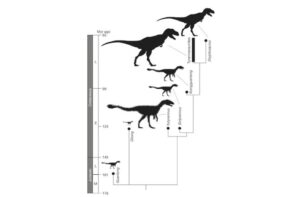
The two fossils I saw, plus a third, all belong to a new species, which Xu has dubbed Yutyrannus huali (a mix of Latin and Mandarin, meaning beautiful feathered tyrannosaur). They had filament-like feathers, reaching several inches in length. Since they are preserved on widely separated parts of Yutyrannus’s body, Xu leans towards the dinosaurs being extensively covered with feathers. Still, he can’t rule out the possibility that they only had patches. Another tricky question is what this discovery means for related dinosaurs, like Tyrannosaurus rex. No one has found T. rex feathers, and, indeed, some researchers have argued that a gigantic dinosaur would trap so much heat in its big body that insulating feathers would be a burden. The discovery of Yutyrannus may mean that’s wrong. Or it may mean that Yutyrannus was an unusually feathery dinosaur. Interesting, it lived in a relatively cold period of dinosaur history, and so plumage may have evolved to be thicker.
These are all good questions that will keep Xu and other paleontologists busy for a while. But in the meantime, I’m just happy I don’t have to keep this experience a secret.
PS–Clark’s forklifted photograph will be appearing in an upcoming issue of National Geographic.
[Images: Xu Xing, Fossil Wiki. Reconstruction paintings: Brian Choo. Close up of feathers: Zang Hailong. Others are mine.]
Originally published April 4, 2012. Copyright 2012 Carl Zimmer.